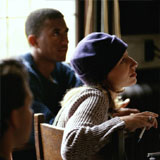|
|
|
|
|
|
|
|
Student reads quietly and stays in one place in the
reading area. |
Student reads quietly. S/he moves around once or twice
but does not distract others. |
Student makes 1-2 comments or noises when reading, but
stays in one place in reading area. |
Student reads loudly, makes repeated comments or
noises OR fidgets and moves about often, distracting others. |
|
|
Student reads the entire period. This may be
independent reading or done with adult or peer assistance, as assigned.
|
Student reads almost all (80% or more) of the period.
|
Student reads some (50% or more) of the time.
|
Student wastes a lot of reading time. |
|
|
Student chooses a book which s/he has not read before,
which is at or above grade level, or has been previous approved by the
teacher. |
Student chooses a book which s/he has never read
before and which is slightly below his/her reading level. |
Student chooses a book s/he has read once before that
is close to his/her reading level and was approved by the teacher.
|
Student chooses a book that s/he has read many times
before or which is more than one grade below student's reading level.
|
|
|
Student is lost in the story. There's no looking
around or flipping through the pages. |
Student seems to be enjoying and moving through the
story, but takes some short breaks. |
Student seems to be reading the story, but doesn't
seem to be very interested. Takes a few short breaks. |
Pretends to read the story. Mostly looks around or
fiddles with things. |
|
|
Stops reading when it doesn't make sense and reads
parts again. Looks up words s/he doesn't know. |
Stops reading when it doesn't make sense and tries to
use strategies to get through the tricky spots or to figure out new words.
|
Stops reading when it doesn't makes sense and asks for
assistance. |
Gives up entirely OR plows on without trying to
understand the story. |
|
|
Student knows the title of the story as well as the
names and descriptions of the important characters. Can tell approximately
when and where the story happened. |
Student knows the names and descriptions of the
important characters and where the story takes place. |
Student knows the names OR descriptions of the
important characters in the story. |
Student has trouble naming and describing the
characters in the story. |
|
|
Student accurately describes what has happened in the
story and tries to predict "what will happen next." |
Student accurately describes what has happened in the
story. |
Student accurately describes most of what happened in
the story. |
Student has difficulty re-telling the story.
|
|
|
Student describes how different characters might have
felt at different points in the story and points out some pictures or
words to support his interpretation without being asked. |
Student describes how different characters might have
felt at different points in the story, but does not provide support for
the interpretation unless asked. |
Student describes how different characters might have
felt at different points in the story, but does NOT provide good support
for the interpretation, even when asked |
Student cannot describe how different characters might
have felt at different points in the story. |
